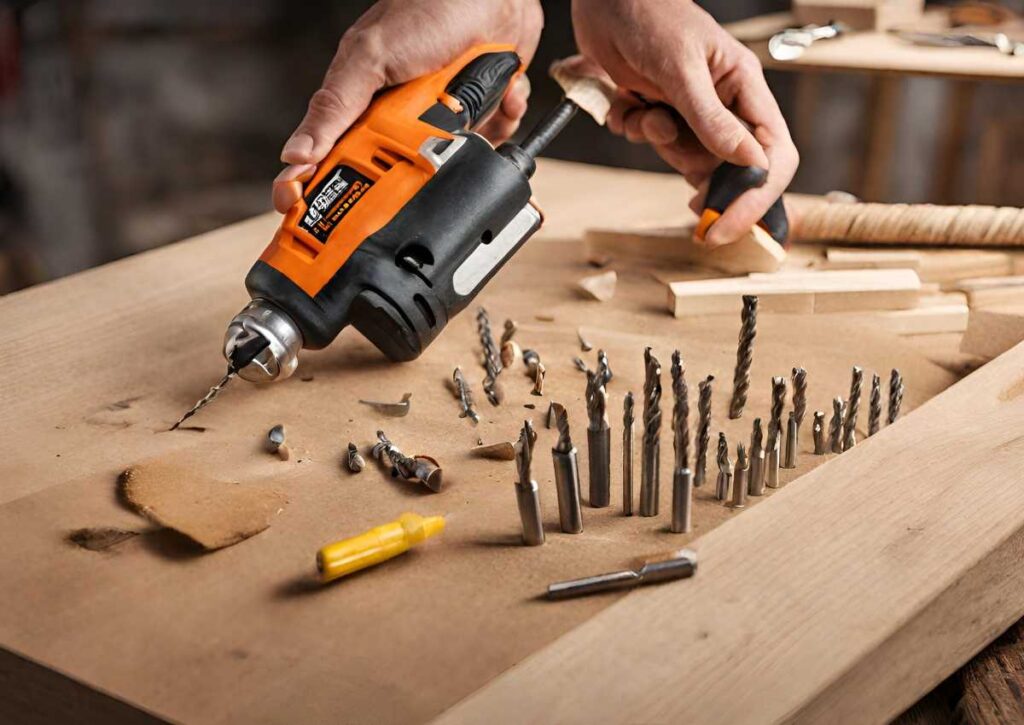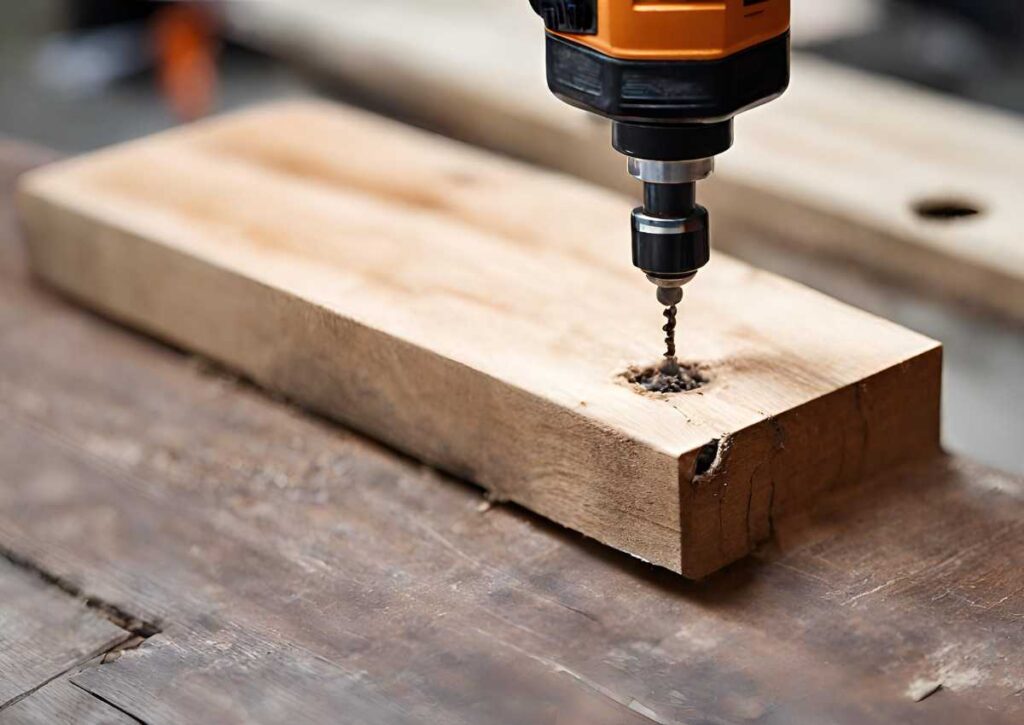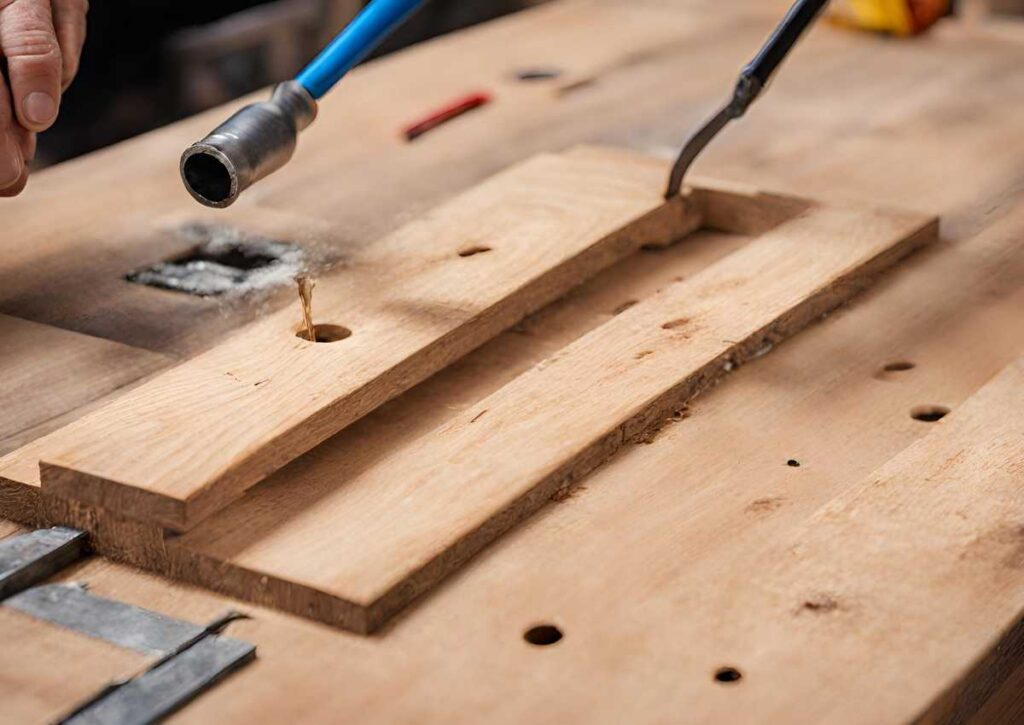If you’re a DIY enthusiast or a woodworker, you probably know the importance of drilling holes in wood.
Whether you’re building a shelf, a table, or a picture frame, drilling a hole is a necessary step in the process.
To drill a hole in wood, first mark where you want the hole. Use a drill bit slightly smaller than the desired hole size.
Place the bit tip on the spot and apply steady pressure while drilling. Remove the bit occasionally to clear wood shavings.
In this blog, we’ll guide you through the steps to drill a hole in wood like a pro so you can confidently tackle any woodworking project.
Types of Wood Drill Bits
Drilling large hole in wood is an essential skill every DIY enthusiast and woodworker should have. But before you start drilling, choosing the right type of drill bit for your project is critical.
Various drill bits are available, each designed for a specific purpose.
Whether you’re aiming to drill a large hole in wood for a furniture project or a home improvement task, selecting the appropriate drill bit is crucial for achieving precise and satisfactory results.
Brad point drill bits
Brad-point drill bits are the most commonly used drill bits for woodworking.
These bits have a sharp, pointed tip that allows them to start drilling precisely on the surface of the wood without slipping or wandering.
Brad point drill bits also have two sharp spurs that cut clean, flat-bottomed holes in the wood. They are available in various sizes and are suitable for drilling holes of different diameters.
Auger bits
are designed to drill deep, clean holes in wood. They have a screw-like thread that pulls the bit through the wood and clears out the chips.
Auger bits are available in different sizes and lengths, making them suitable for drilling small and large holes in thick or thin wood.
Spade bits
Spade bits, or paddle bits, have a flat, paddle-shaped blade that cuts through the wood. They are ideal for drilling large-diameter holes in softwood but may need help with hardwoods.
Spade bits come in various sizes and are best used with a drill press to ensure a straight and accurate hole.
Forstner bits
Forstner bits are used to drill flat-bottomed holes with smooth sides in wood. They have a centre point that helps them stay on track and a circular rim that cuts the hole’s perimeter.
Forstner bits are available in various sizes and are ideal for drilling holes for dowels or concealed hinges.
Hole saws
Hole saws are cylindrical blades used to drill large-diameter holes in wood. They have a centre bit that guides the edge and keeps it centred on the hole.
Hole saws are commonly used to drill holes for installing doorknobs, pipes, or conduits. They are available in various sizes and are best used with a drill press.
Choosing the right drill bit for your project is essential to ensuring a precise and clean hole.
Whether you need to drill small or large, deep or flat-bottomed holes, there’s a drill bit available to meet your needs.
Essential Tools and Accessories

Before drilling a hole in wood, having the right tools and accessories is essential.
Power Drill Options
There are several options for power drills for drilling holes in wood. The most common types are cordless drills and corded drills.
Cordless drills offer greater portability, while corded drills provide more power and consistent performance.
When selecting a power drill, consider the size of the drill bit you’ll be using, the type of wood you’ll be drilling into, and the size of the hole you need to create.
Drill Press
A drill press is a stationary machine explicitly designed for drilling holes in wood. It provides greater accuracy, consistency, and control than a handheld drill.
The drill press also allows you to adjust the hole’s depth and the drill bit’s angle. If you plan to do many woodworking projects, a drill press is a worthwhile investment.
Clamps and Workbenches
It’s crucial to secure it in place. Clamps and workbenches are essential tools for holding the wood in place.
Clamps can be used to secure the wood to a workbench, while workbenches provide a sturdy surface for drilling. Be sure to choose a workbench with the appropriate size and height.
Safety Gear
Safety gear is a must when working with power tools. Wear eye protection, hearing protection, and a dust mask when drilling holes in wood.
Eye protection will prevent wood chips from getting into your eyes; hearing protection will reduce the noise level of the drill; and a dust mask will protect you from inhaling wood dust.
Woodworking Measuring Tools
Accurate measurements are essential when drilling holes in wood.
Measuring tools such as a tape measure, ruler, or square will help ensure the hole is drilled in the right location and depth.
When using measuring tools, measure twice and cut once to avoid mistakes. It’s also a good idea to mark the hole’s location with a pencil or marker before drilling.
Drill A Hole In Wood (7 EASY STEPS)

Drilling a hole in wood may seem simple, but it requires the right tools and techniques to ensure success.
Selecting the Appropriate Drill Bit
The first step in drilling a hole in wood is to select the appropriate drill bit. For most wood drilling tasks, a twist bit is suitable.
However, other types of bits are available, such as spade bits, auger bits, and hole saws, which may be better suited for specific tasks.
When selecting a drill bit, consider the size and depth of the hole you need to drill, the type of wood you are drilling into, and the type of drill you use.
Measuring and Marking the Drilling Location
Once you have selected the appropriate drill bit, the next step is to measure and mark the drilling location.
Use a ruler or measuring tape to measure the distance from the edge of the wood piece to the centre of the hole you want to drill. Then, mark the centre of the hole with a pencil or marker.
Securing the Wood Piece
Before you start drilling, securing the wood piece is essential to prevent it from moving or vibrating during the drilling process.
You can use clamps or a vise to hold the wood piece in place or secure it with your hand if the wood piece is small enough.
Setting Up the Drill and Adjusting the Speed
Before drilling, ensure your drill is set up correctly and the speed is adjusted accordingly. Insert the drill bit into the chuck and tighten it securely.
Adjust the drill speed based on the size of the drill bit and the type of wood you are drilling into.
Generally, lower speeds are better for more significant drill bits and harder woods, while higher rates are better for smaller drill bits and softer woods.
Drilling A Pilot Hole
To ensure accuracy and prevent the wood from splitting, it’s a good idea to drill a pilot hole before drilling the central hole.
Use a more minor drill bit to drill a shallow hole in the centre of the marked location. This will guide the more significant drill bit and prevent it from wandering off course.
Drilling the Main Hole
With the pilot hole drilled, it’s time to drill the central hole. Keep the drill perpendicular to the wood surface and apply gentle pressure to start the hole.
Once the hole is formed, gradually increase the pressure until the drill bit is drilling at full speed. Take your time and avoid forcing the drill bit, which can cause it to overheat or break.
Cleaning and Finishing the Hole
Once you have drilled the hole, cleaning up any debris or sawdust left behind is essential. You can use a brush or a vacuum to remove the trash.
If you want a clean and smooth finish, you can use sandpaper or a file to smooth the edges of the hole.
Tips and Tricks for Perfect Holes

Drilling a hole in wood seems like a simple task, but some techniques and tricks can make the difference between a sloppy hole and a perfectly drilled one.
Preventing tear-out
Here are some tips to prevent tear-out when drilling a hole in wood:
- Use sharp drill bits; dull drill bits push the wood fibres aside rather than cut through them, causing tear-out. Use sharp drill bits and replace them when they become dull.
- Back up the wood: To prevent tear-out, clamp a sacrificial piece of wood to the back of the board before drilling the hole. This way, the wood fibers will tear out on the sacrificial piece rather than your project.
- Use a piece of tape: Applying a piece of tape over the area where you will drill the hole can also help prevent tear-out. The tape will help hold the wood fibers together and minimize splitting or tearing.
Drilling at an angle
Sometimes, you may need to drill a hole at an angle rather than straight through the wood. Here are some tips for drilling at an angle:
- Mark the angle: Use a protractor or angle finder to mark the exact angle you need to drill. This will help ensure that your hole is at the correct angle.
- Secure the wood: When drilling at an angle, it’s essential to secure the wood firmly in place to prevent it from slipping or moving during drilling. You can use clamps or a vice to hold the wood in place.
- Use a guide: A drilling guide can help you maintain the correct angle and steady the drill bit. You can purchase a drilling guide or make your own using scrap wood.
Drilling deep holes
Drilling deep holes in wood can be challenging, especially if you need a drill press. Here are some tips for drilling deep holes by hand:
- Use a long drill bit: Choose a drill bit long enough to reach the depth you need to drill. A more extended drill bit will help keep the hole straight and prevent the drill from wandering off course.
- Drill in stages: Rather than trying to drill the entire depth in one go, drill in steps, pulling the bit out periodically to clear and cool the chips. This will help prevent overheating and make the drilling process more accessible.
- Use a depth stop: A depth stop is a collar that fits onto the drill bit and prevents it from drilling beyond a certain point. A depth stop will help ensure you drill to the correct depth.
Stopping at a specific depth
Sometimes, you may need to drill a hole to a specific depth, but stopping the drill at the exact point you need can be tricky. Here are some tips for stopping at a particular depth:
- Use a depth gauge. A depth gauge is a measuring tool that can help you determine the depth of the hole you are drilling. You can use a depth gauge to mark the drill bit with tape or a marker to indicate where to stop.
- Use a depth-stop collar. A depth stop collar is a collar that fits onto the drill bit and allows you to adjust the depth at which the drill bit stops. This can be particularly helpful if you need to drill multiple holes to the same depth.
Conclusion
As we conclude this guide on how to drill a hole in wood, let’s take a moment to review the key points we covered.
By now, you should clearly understand the tools and techniques necessary for drilling a hole in wood, as well as the safety precautions you should take to avoid injury.
Select the correct drill bit size for your project, drill at the right speed, and use clamps or a vice to secure your workpiece.
If you want to continue your woodworking journey and expand your skills, plenty of further resources and guidance are available.
You can check out online tutorials and videos, attend woodworking classes or workshops, or even connect with other woodworkers in your community.
With practise and patience, you’ll be able to tackle more complex woodworking projects and achieve professional-quality results. So don’t be afraid to experiment and have fun!
FAQs
Can you drill directly into wood?
Yes, you can drill directly into wood using a drill. Make sure to choose the right type of drill bit for wood and secure the wood properly before drilling.
What is the best tool for drilling holes in wood?
The best tool for drilling holes in wood is a power drill with the appropriate wood drill bit.
Cordless drills are convenient, and different bits can be used for various hole sizes and types of wood.
How do you bore a large hole in wood?
To bore a large hole in wood, use a hole saw attachment on your power drill. Mark the center of the hole, attach the hole saw, and drill at a low speed, applying steady pressure.
Clear wood chips regularly for smoother cutting.
How do you drill a hole in thin wood without cracking it?
To drill a hole in thin wood without cracking it, start by placing a scrap piece of wood beneath the target area.
Use a sharp wood drill bit, and drill at a slow speed while applying gentle pressure. This minimizes the risk of splintering or cracking.
Also Read
Exploring the Versatility of Aircraft Drill Bits: Everything You Need to Know
Drill Bit For Christmas Tree: The #101 Answer Stand Drill Bit









